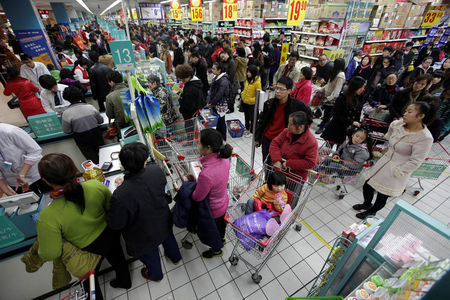When will China deflation have a higher weight in policy calculation?
2024.09.14 02:14

Investing.com — China’s deflationary pressures have become a growing concern, as recent data continues to reveal widespread price declines and weak demand. Despite some reflationary attempts, policymakers remain focused on real GDP growth rather than nominal inflation figures.
As per analysts at Citi Research, the question of when deflation will begin to carry more weight in policy calculations centers on whether the authorities perceive real growth to be under significant threat.
Citi Research report points to the inflation readings from August as the latest evidence of deflationary pressure.
While food prices surged due to supply constraints caused by weather disruptions, contributing to a 3.4% month-over-month increase, this was not enough to offset the overall weakness in demand.
Core inflation, excluding volatile components like food and energy, dropped to its lowest level since 2016, with core goods prices particularly affected.
Home appliances, telecom equipment, and automobiles all saw sharp declines, signaling softness across various sectors. Services prices also contracted, with tourism demand easing significantly compared to previous years.
The Producer Price Index (PPI), which reflects changes in prices received by domestic producers, also registered deeper deflation than expected.
In August, PPI deflation worsened with a 1.8% year-over-year drop, driven largely by falling upstream commodity prices, such as oil and ferrous metals. Downstream industries, like durable goods and automobiles, showed little improvement, with only minor sequential changes.
Despite the surge in food prices, the underlying narrative of broad-based demand weakness remains.
“Looking ahead, online sales events into November may add further downside risks to inflation. Soft oil prices may not bode well for industrial prices either,” the analysts said.
The structural issues within the Chinese economy have been vital in maintaining this deflationary environment.
Citi notes that while food price inflation persisted, it failed to lift the broader inflation metrics due to the persistently weak demand across most sectors.
Consumer sentiment remains fragile, with cautious spending and limited appetite for big-ticket purchases like automobiles and electronics.
The anticipation of lower prices, especially during upcoming online sales events like November’s, intensifies concerns.
Combined with global factors such as low commodity prices, China’s domestic economy faces mounting challenges.
The government’s current policies appear insufficient to stimulate widespread recovery, as demand remains sluggish and producers continue to face an uphill battle.
The consequences of deflation in China are complex. Citi Research highlights two main dimensions of its impact.
First, deflation could entrench the economy in a vicious cycle, where falling prices reduce corporate revenues, which in turn leads to weaker wages and diminished household demand.
This feedback loop deepens deflationary pressures, making it harder to break free from the cycle.
Second, deflation heightens the disconnect between macroeconomic indicators and policy responses. Despite nominal deflation, the government’s primary focus has remained on real GDP growth.
“Some minor reflationary moves could have started, yet with the policymakers’ primary focus on real GDP, we may not see a policy pivot until real growth becomes more challenging,” the analysts said.
Citi Research argues that deflation has not yet become a key consideration in policy-making because the government’s attention is still centered on real GDP growth.
The current policy stance is based on the assumption that, as long as real growth holds steady, inflationary and deflationary pressures are secondary concerns. So far, minor reflationary moves have been observed, such as the government’s emphasis on addressing “anti-involution” strategies. Certain sectors, like cement production, have taken steps to clear excess capacity, which may pave the way for price growth in the future.
However, these moves are seen as sector-specific adjustments rather than broad-based measures to counteract deflation.
Without improvement in end demand, these strategies are unlikely to reverse the deflationary trend.
For the time being, the broader policy paradigm remains unchanged, as policymakers seem to believe that nominal deflation does not pose an immediate threat to the broader economy.
The key question posed by Citi Research is: When will deflation begin to carry more weight in policy decisions? As per their analysis, the answer depends on whether real growth begins to falter.
At present, deflation has not prompted a major shift in government thinking because the primary focus remains on maintaining steady real growth.
However, if economic conditions worsen and downside risks to real growth become more pronounced, deflation will inevitably take on greater importance in shaping policy responses.
While some initial efforts to address deflation are evident, such as the government’s efforts to reduce excess capacity in specific industries, these moves are unlikely to make a difference without an improvement in underlying demand.
Citi analysts caution that if deflationary pressures continue to intensify, a broader policy pivot could be necessary to support both consumer and corporate confidence.








